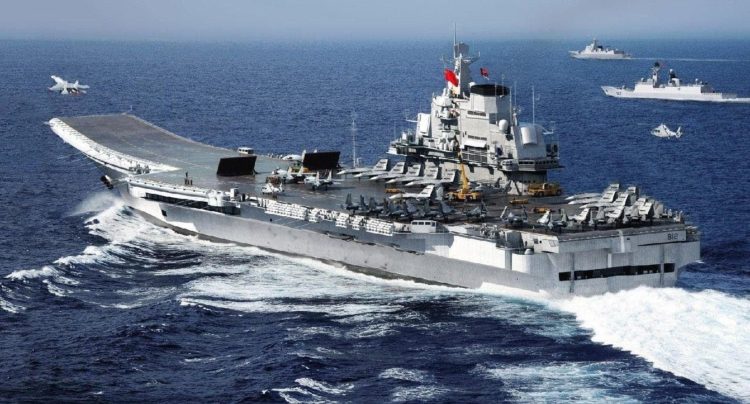The Chinese Navy is currently amid a new effort to assess and train experienced naval aviators to serve in warship command roles in the nation’s still-developing blue-water navy.
China’s second aircraft carrier, its first home-built vessel of this kind, is currently undergoing sea trials. Another is currently under production and more are planned for the coming years (despite some recent economic setbacks). This endeavor, alongside the launch of numerous other vessels and economic initiatives aimed at establishing friendly ports the world over, aims to position China as America’s primary competitor on the high seas. However, the effort to field qualified carrier strike group commanders has highlighted some of the shortcomings that China’s rapidly growing military still must contend with.
According to Chinese state media, the pilots who were selected for further command training all had to pass a series of ten assessments, ranging from psychological wellness to personal politics, in order to qualify.
“Aircraft carrier strike groups are supposed to sail on the high seas and into unfamiliar territory, so aside from having a background as naval aviators, all commanding officers should have a broad set of skills and knowledge — from foreign languages and international maritime law to air and sea operations — to help them make good decisions,” explains Beijing-based naval expert Li Jie.
But despite the rigorous testing, China’s future strike group commanders will fall far short of America’s in terms of both naval and combat experience. China has not participated in the global War on Terror to the same extent as many other nations, and hasn’t fought in anything that really resembled a war in decades — that means no one in the sprawling People’s Liberation Army-Navy has the same degree of direct combat operations experience that can be found in your average chow hall on an American military base — let along among the Navy’s elite commanders. But it’s not just combat experience that the Chinese leadership will be lacking when compared to its American counterparts — it’s also command experience in general.
Before taking the job as the commander of the USS Ronald Reagan, one of America’s Nimitz-class supercarriers, Captain Pat Hannifin collected a massive 2,800 flight hours in 33 different aircraft, ensuring he has a thorough understanding of the challenges and capabilities of the aircraft at his disposal. His resume didn’t end there, however, as America’s already mighty Navy also gives its leaders the opportunity to train aboard operating carriers in a number of capacities before taking command. Hannifin already served as the commander of an amphibious transport dock, as well as serving as the executive officer aboard another carrier, before taking command of the Reagan. In China this simply isn’t feasible. 
USS Ronald Reagan Strike Group (U.S. Navy)That experience divide isn’t just manifested at the command of naval vessels; it’s also at the stick of each nation’s respective aircraft. Here in the States, the U.S. Air Force is currently amid a push to extend pilot flight hours to 20 per month, an uptick from the previous average of 17.8. Marine Corps aviators currently clock an average of 14 to 16 hours in the air per month, and Army and Navy pilots tend to fall right in that same neck of the woods. That means that every U.S. military pilot spends between 168 and 240 hours per year at the stick of their aircraft.
It’s tougher to nail down a similar figure for Chinese aviators for two reasons: The first is that China tends not to make such information publicly available; and the second is that the People’s Liberation Army-Air Force is currently amidst a massive overhaul of their flight training operations.
The sparse available details of the overhaul actually paint an even worse picture for China, if their pilots were ever to face off against Americans in the skies over the Pacific.
According to a Rand Corporation analysis of the PLA-AF’s pilot training transition, Chinese fighter pilots have been trained to follow orders relayed from senior leaders on the ground — unlike American fighter pilots, who usually take their cues from the senior pilot in the group during combat operations. China began to recognize how poorly this methodology translated to a dynamic battle space during training, when rapid shifts in targeting data resulted in confusion and frequent misses that were attributed to a lack of leadership at the point of conflict. Now, Chinese aviators are being given a great deal more autonomy in their operations, but the process is still in its early stages and it will likely be years before their training regimen begins producing well-rounded pilots that don’t require command hand-holding.
What does that mean for aviators transitioning into leadership roles in the Chinese Navy? That despite a thorough vetting, they will still fall far behind their American peers in terms of operational and leadership experience and even command autonomy. China’s Navy may be growing rapidly, but its lack of experience is something that tends to get lost amidst the headlines about technological advances and training efforts. These differences aren’t as easy to spot as a new airplane or destroyer — but they could mean everything in a large scale conflict.
Already have an account? Sign In
Two ways to continue to read this article.
Subscribe
$1.99
every 4 weeks
- Unlimited access to all articles
- Support independent journalism
- Ad-free reading experience
Subscribe Now
Recurring Monthly. Cancel Anytime.










